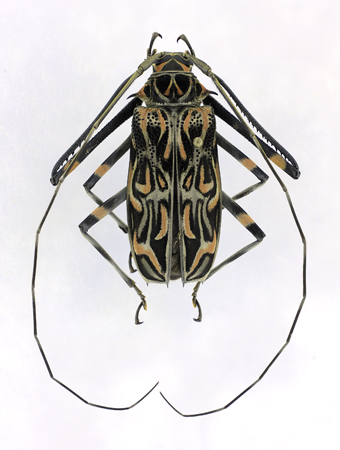 |
Acrocinini
Classification
Introduction
- The tribe Acrocinini Swainson & Shuckard, 1840 currently contains 1 species in 1 genus. The only species in this tribe, Acrocinus longimanus, is commonly referred to as the Harlequin Beetle.
Diagnostic Features of Adults
- Body large-sized, approximately 40 mm or longer; generally elongate. Eyes generally reniform, complete (not completely divided into upper and lower lobes). Antennae filiform, unarmed; antennae long, generally extending beyond elytral apices by several segments. Head without distinct lateral or anterior projections. Pronotum transverse (distinctly wider than long); lateral margins of pronotum with distinct acute spines. Mesocoxal cavity open to mesepimeron. Wings complete. Legs with tarsal claws smooth; claws broadly divergent (divaricate); profemora distinctly elongated, especially in males. Elytral humeri distinctly modified with acute spines.
Diagnostic Features of Larvae
- Larva. Form elongate, strongly depressed; integument firm, covered with short, rather stiff hairs. Head very strongly depressed, sides regularly and strongly converging posteriorly; epistoma straight; labrum a little wider than long, broadly rounded, widest near base; mandible slender, elongate, length about three times condylar width, cutting-edge shallowly emarginate, antennal ring faintly bisected by frontal suture. Ventral mouth-parts elongate; mentum twice as wide as long, distinct; last joint of maxillary palpus shorter than penultimate, much shorter than last labial; anterior edge of hypostoma straight; gula not distinct. Prothorax depressed; pronotum posteriorly beset with chitinous, conical papillae, as also are the ampullae; pleural tubercles broadly oval, having a chitinous pit at each extremity and five or six setae; spiracles broadly oval, peritreme thin. Adapted from Craighead (1923).
Geographic Distribution of Tribe
Biology and Economic Importance
- Acrocinus longimanus is commonly collected at lights and on dead or dying trees, especially strangler fig (Ficus spp.). This species is known from a variety of host plant families, including the economically important families Fabaceae and Sterculiaceae.
Selected References to Adult Specimens
Selected References to Larvae Specimens
|  |

Acrocinus longimanus
(Linnaeus, 1758); dorsal
♀ specimen
Cerambycidae:Lamiinae:Acrocinini
Photograph © A.M. Hodson
|




